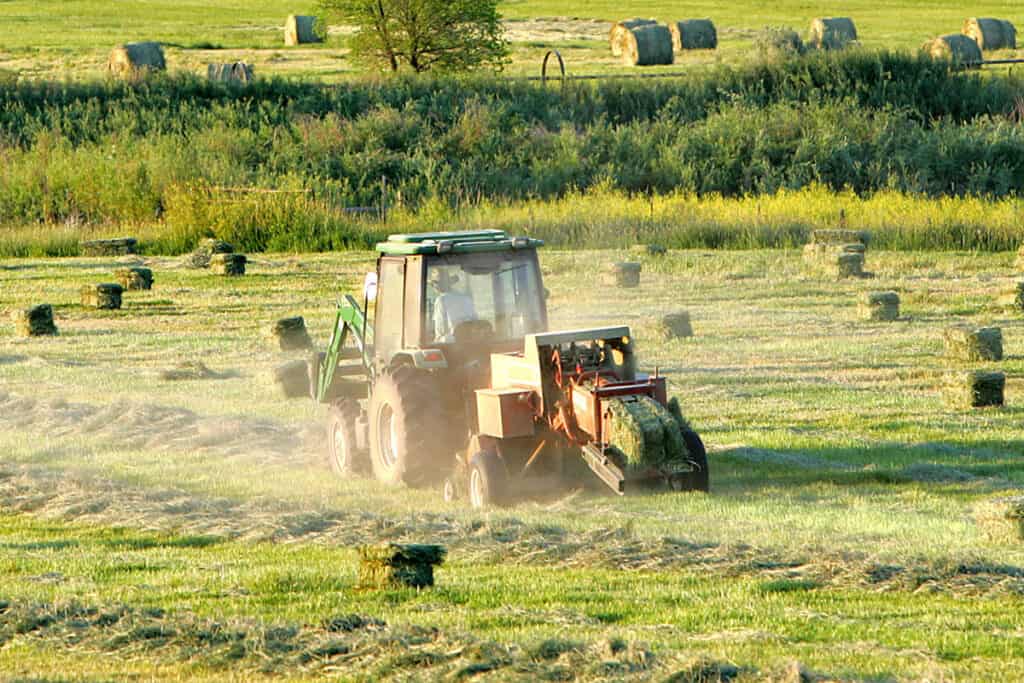©Gary Hubbell 2007, 2014. All rights reserved. May not be used or reproduced in ANY form without the express written consent of the author. All photos copyright Gary Hubbell. All rights reserved.
Mountain grass/alfalfa hay for sale, large round bales and small square bales. Grown in a mountain setting in Crawford, Colorado. Excellent quality horse hay and cattle hay. For more information, see our website at www.mountainhay.com or call Gary Hubbell at 970 988-2122.
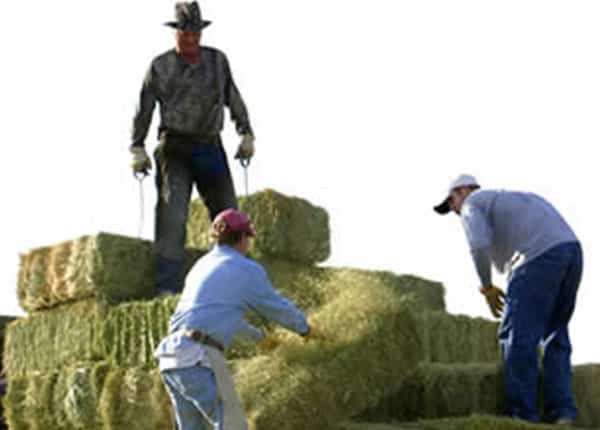
As our cities get bigger and busier and lifestyles become more hectic, thousands of people every year decide to heck with that lifestyle and move out to the country. The idea is to do some work over the internet, maybe some consulting, and raise a few horses or cows on a small acreage—let’s say 40 acres. Live the quiet life! Do a little farming! Slow down! Great. It’s a wonderful idea, and I’ve done it myself. Now that you’ve got that 40 acres, you decide you want to raise some hay on it. I’m going to make the assumption that you’ve figured out how to irrigate and fertilize your fields, and you’ve grown a beautiful, thick stand of hay. Now it’s time to cut it and bale it. At this point, there are two ways to go: you can acquire all the equipment yourself, or you can hire a custom farmer to come in and cut, bale, and stack your hay.
THE ECONOMICS OF SMALL FARM HAYING EQUIPMENT
Economically speaking, it’s much cheaper for you to hire the custom farmer to do the job. He’s got the equipment to do the job quickly and efficiently. It will cost approximately $45-60 a ton to have him cut, bale, and stack your hay.You can’t possibly amortize buying and maintaining all the equipment to cut your hay for that amount. But here’s the problem: scheduling. When you wake up one fine morning and the sun is shining, the weather report says five more days of great weather, your hay is thick and tall, and you turned off the irrigation water a week ago so your fields would be dry to cut—and the custom hay fellow says he can’t get there for two more weeks, minimum. The two weeks turns into more like three weeks, and the day he shows up to cut is the day that it starts to rain. Hopefully your hay won’t lie there on the ground for two weeks of rain, but then again, it might. That gets really frustrating—frustrating enough that you’ll start trying to buy your own equipment. Truly, it will never make financial sense to buy the equipment to cut 40 or 50 acres of hay. It starts making sense at about 100 acres. However, if you insist on cutting your own hay, you’re going to need a mower; a baler; and a stackwagon or tractor to stack your hay.
SMALL SQUARE BALES, SMALL ROUND BALES, LARGE ROUND BALES, OR BIG SQUARE BALES?
There are very basic divisions in haying equipment. First, you need to decide if you want to put up small square bales, small round bales, large round bales, or large square bales. Small square bales used to be the norm to feed both horses and cattle, but now very few cattle ranchers still put up small square bales. Small square bales are actually rectangular (14” x 16” x 42” long) and weigh anywhere from 50 to 75 pounds. One square bale typically feeds three horses for a day. Women can handle them, and you don’t need a tractor, which make them a popular item for horse hay. Small square bales require a lot of labor and handling. The term “bucking bales” and the labor required–well, that means small square bales. You can imagine how much more efficient it is to feed one round bale versus stacking, handling, and feeding 30 square bales. If you have hundreds of cattle to feed, you’d spend all day handling enough square bales to feed them all, and you’d be exhausted at the end of the day.
Most horse people prefer to put up small square bales. If you’re feeding a half dozen horses a day, it’s most convenient to feed small squares. You can easily weigh the bales and feed the correct amount to individual horses. However, these bales are extremely labor-intensive to bale, transport, and store. Have you ever stacked ten tons of small square bales in a small barn? It’s a grind. Have you ever picked up 80 tons of small square bales from a field? It’s a big, labor-intensive job.

Do you know where you can hire three stout guys who will work really hard for half a day to load a semi with hay? If so, call me! They’re hard to find!
Round bales are large and heavy, and it takes more of a tractor to put up round bales. You need to research very carefully how big of a tractor you need to drive a round baler. Usually it takes AT LEAST 55 PTO horsepower to run a round baler. Be sure to note the difference between “engine horsepower” and “PTO horsepower.” The first designation is what the engine produces. The second designation, the PTO horsepower, is the amount of power actually delivered to the implement. (By the way, do you know what a PTO is? It’s the Power Take Off device, a spindle on the back of the tractor that powers implements such as brush cutters, balers, posthole diggers, and other devices). You can run a small baler with a 40-HP tractor, but you won’t be able to make the smallest round bales with that tractor. The smallest round balers make a 4-foot x 5-foot round bale that weighs between 750 and 900 pounds. That baler will be called a “four-by-five” round baler. These bales are very handy for small cattle farms, horse farms, and other small animal husbandry operations, such as goats and sheep. You can spear and load them with a 35- or 40-hp tractor, and you can load one in the back of a pickup. If you want to ship them, they fit easily on a semi without hanging over the sides, mandating “OVERSIZE LOAD” regulations. We have a 56-hp tractor that does a great job of making bales with a 4×5 round baler. The bales typically weigh 850-900 pounds.
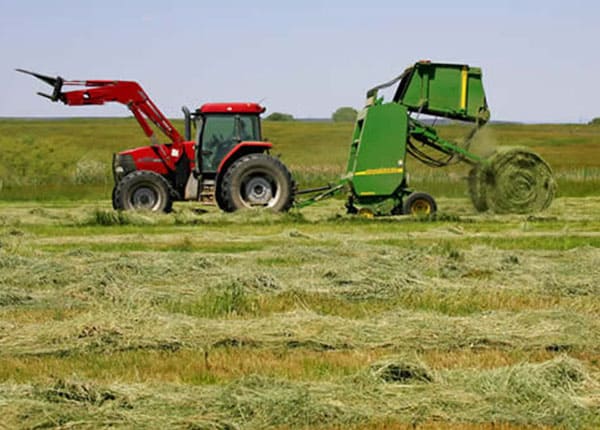
This tractor is a 105-hp with front-wheel assist, and offers plenty of power for running this large round baler.
Another advantage of round bales is storage. In Colorado, where we get snow and rain but the weather is generally low humidity, you can store round bales uncovered and the hay will remain excellent in quality. The water just rolls off them without causing mold. Square bales, however, MUST be stored under cover! If you stack square bales without a good shelter to put them under, water will penetrate the stacks and cause hay to mold, sometimes as far as three or four rows down. Hay tarps are expensive and a poor solution at best. They wear out quickly and it’s easy for water to slip in between tarps and ruin hay.
Most square bale buyers are buying horse hay, and horses do not tolerate moldy hay well at all. If you put up square bales without adequate dry storage, such as a hay barn, you’re really wasting your time and money. Cows can tolerate a certain amount of mold in hay, but bright green hay is best for all animals.
TRACTORS TO PULL HAYING EQUIPMENT
If you intend to put up round bales, your tractor should be 75-90 horsepower. Have you looked at tractors that size? They’re EXPENSIVE. You can spend as little as $25,000 for an old used 75-hp tractor and as much as $80,000 or more for a new one. Mind you, the tractor must be equipped with a front-end loader bucket that will also accept a round bale spear attachment so that you can move your bales once they’re on the ground. If your tractor is not equipped with one, a loader attachment can run between $5,000 and $8,000, depending on the make and model. (Make sure the loader arm is equipped with a skid steer plate, because then you can accept many different attachments.)
As long as we’re talking about tractors, I strongly suggest three things on any tractor for mountain ranch use: front wheel assist (basically four-wheel-drive), a shuttle shift (makes it easy to shift from forward to reverse), and a CAB. You may think spending an extra $5,000 for a cab is wasted money, but wait until you’re baling hay in 95-degree heat and you’re dripping sweat and covered with itchy hay dust, while you could be riding along in air-conditioned comfort with good music on the stereo. The same goes for winter. If you’re out feeding cattle in 20-below-zero conditions with the wind howling at your back, you’ll be cussing the money you saved when you think about a nice warm cab with the heater on.
If you intend to put up only small square bales, you can get by with a 40-45 horsepower tractor. HOWEVER, keep two things in mind! 1) The PTO horsepower is not the same as the engine horsepower—it’s less; and 2) you lose horsepower as you go up in elevation. A tractor producing 50 horsepower at sea level may produce only 43 horsepower at 7,000 feet in elevation. If your baler requires 40 horsepower to run it, your 40-hp tractor may be seriously underpowered!
I can go into a lengthy discussion of the makes and models of tractors. In fact, I could write a book about it. Tractors are not a high-tech item. They are currently manufactured in India, Ireland, Russia, Korea, Japan, Mexico, China, and many other countries. Even if you buy a tractor with a good old American brand name, it could have a transmission manufactured in England, electronics from China, and a frame made in India. Do your research and talk to local farmers. See what they’ve found to be reliable and dependable. You can buy tractors from dealers three states away, but once your new tractor breaks down, who is going to service it? Make sure you have a local parts and service connection, because learning tractor mechanics the hard way is no fun.
Used tractors can have many hidden mechanical problems, and if you’ve found a great deal on a tractor 800 miles away, there’s probably a reason. Once you pay several thousand dollars to have the tractor delivered and then discover the transmission is bad, you’ll end up wishing you had bought locally from a reputable source.
A couple of tips: make sure you buy enough horsepower and get as much tractor as you can afford. If you buy a 37-hp hobby tractor and try to bale hay with it, it probably won’t work. A 20-year-old tractor with 6,000 hours on it is TIRED. That means you’d have to drive that tractor 40 hours a week, 50 weeks a year, for THREE YEARS to get that many hours on it.
Hydraulics are almost as important as horsepower. Make sure your tractor has plenty of hydraulic outlets and a big enough hydraulic pump to run your equipment. For example, a skid steer post-hole auger mounted on your front-end loader is a very effective tool. If your hydraulic pump only puts out ten gallons a minute, you won’t be happy. It will barely turn the auger. The auger requires 18 gallons a minute, and then you’ll dig post holes like there’s no tomorrow.
We bought as much tractor as we could afford: a 57-hp front-wheel-assist with a cab and loader. Brand new, it was $30,000 in 2005. It’s plenty of tractor for hauling gravel, picking up round bales, digging post holes, running a square baler, and many other ranch tasks. However, we found out late in the game that it’s NOT big enough to run most round balers or power a rotary mower with conditioners. Do I wish I had a bigger tractor? Yes. Can I get by with the one we have? Yes. We bought a tractor from a new manufacturer and saved over $15,000 over buying from a long-established American manufacturer. Generally, we’ve been very pleased, but we also had one rather serious issue, as the loader arm broke right in the middle of haying season.
A basic dividing line is this: if you want to put up round bales, get a tractor in the 75-105 horsepower range. For square bales, get at least 45 horsepower.
CUTTING YOUR HAY: SWATHERS, HAY MOWERS, AND SICKLE BARS
Let’s talk about mowers. Again, you have several choices. Ideally, a rancher should have a tractor to bale the hay and a self-propelled swather to cut the hay. There are times when you don’t want to depend on one machine to run all your implements. You can run both a mower and a baler off the same tractor, but what happens when you need to cut and bale at the same time? Or what if the tractor breaks down? Swathers, however, are expensive! New machines with 14-foot and 16-foot heads cost upwards of $125,000. Used machines can be found for much less, but often you’ll spend a lot of time practicing your mechanical skills. Good used swathers are very hard to find, and expensive when you find a good one. Transportation is also an issue, because the 14-foot or 16-foot head must be removed and still the tractor is so wide that the trailer hauling it must be a step-deck lowboy, requiring “wide load” permits and additional fees. I priced shipping a swather from Missouri to Western Colorado, and the lowest price I could find was $3,200, and that was before fuel prices went up. If you’re cutting 100 acres or more of hay, I would seriously consider investing in a good used self-propelled swather.
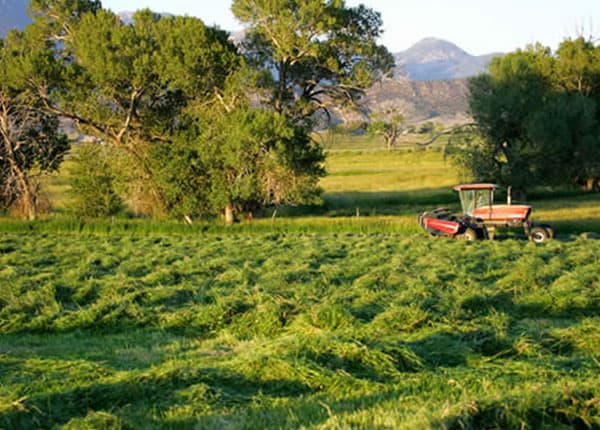
This swather is five years old and has a lot of hours on it. Still, it’s worth over $40,000. A new one costs $125,000 or more.
Pull-behind Hay Mowers
If you can’t find or afford a swather, you can buy mowers that you pull behind a tractor. These come in two basic designs: sickle bar cutters or rotary cutters. Rotary cutters are better for thick grass mountain hay, but they are expensive, more complicated machines and require big tractors with a lot of horsepower to run them. Sickle bar mowers are really an old technology, but still effective. Sickle bar mowers are not as efficient at cutting heavy grass hay and can get clogged up more easily, but they’re easier to find used at reasonable prices and don’t require as much horsepower to run.
Disc mowers are pulled behind a tractor and have between five and nine rapidly spinning blades that cut the hay and pull it through two rollers (called conditioners) that break the stems of the hay so that it will dry more easily. The conditioners then pile the hay in a windrow that can be easily picked up by a baler. You need at least 70 hp to run a decent-sized rotary cutter with conditioners—and by the way, the cutters run at least $22,000 new.
A second rotary cutter option is to buy a mower without conditioners that just cuts the hay and leaves it lying on the ground with no windrow. Because it’s lying where it fell, the hay dries pretty quickly, but then again, you have to cover the entire field again with a hay rake to pile it in windrows. That means buying a hay rake and the diesel fuel to make another entire pass over your fields, and tying up your tractor when you might want to use it for baling hay or some other task. The conditioners require quite a bit of horsepower, so you can buy one of these disc mowers without conditioners to use on a smaller tractor, say 40-50 horsepower. Some of these cutters are small, with only 7-foot or 9-foot cutting swaths, so they are good for small acreages.
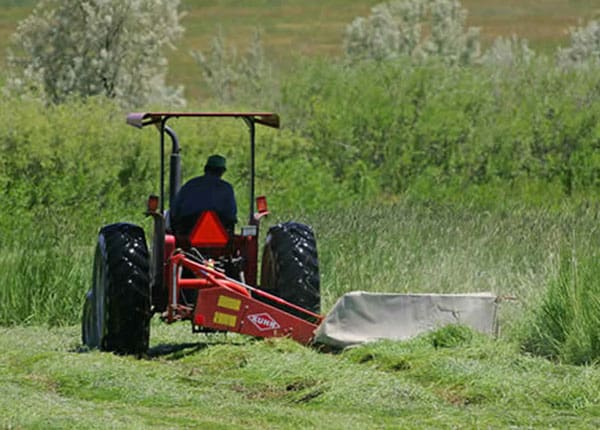
This tractor is pulling a small rotary mower without conditioners that simply cuts the hay and leaves it lying where it falls. The hay must then be windrowed and then baled. A smaller tractor can be used to pull this rotary cutter.
Sickle bar mowers such as a Hydroswing can be pulled behind the tractor and come in configurations as small as 9-foot cutting heads and up to 14 feet. The smaller mowers take as little as 45 horsepower to run, so this is a good solution for the small farmer with a limited budget. I’ve seen them used in good condition for as little as $5,000, and new ones can be found for $15,000 and up.
If you want to go really simple, you can get an old-style sickle bar mower
Square Balers-two-strand 70-pound Horse Hay Bales
You can find old beat-up square balers to bale your hay into the small square bales that horse people like for a minimum of around $3,500. If you’ve ever seen the mechanism of a bale knotter, it’s a wonder that anyone ever engineered such a curious device. Buying an old, beat-up used baler is a certain invitation to frustration. You’ll find out how good a mechanic you are with 50 tons of hay on the ground and a thunderhead looming behind you as you sweat and cuss underneath a rusty machine.
New square balers can be had for between $16,000 and $22,000, and they’re worth it. John Deere and Hesston are the two main manufacturers of new square balers. Both make a “hobby farmer” model that is more than adequate for putting up a couple hundred tons of hay a year—the John Deere 327 and the Hesston 4550. The Hesston is an in-line baler, which means that you can straddle the windrow of hay as you’re driving along. Some farmers find that to be an advantage, because you don’t have to look back over your shoulder to make sure you’re picking up all the hay in the windrow. It saves on neck soreness, and it’s a little easier to make turns.
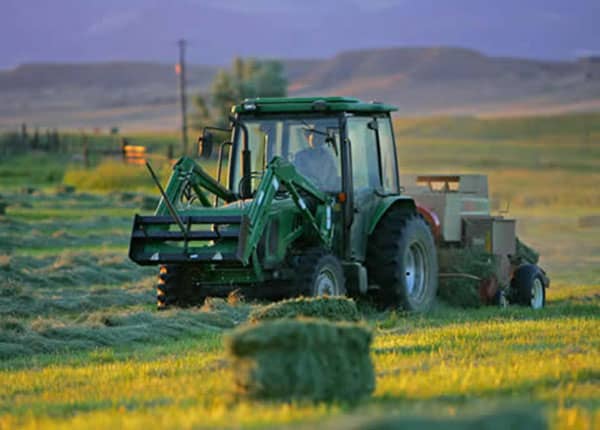
This inline square baler is easy to drive over the windrows and produces nice tight bales.
For heavier production, the John Deere 348 and the Hesston 4590 are excellent balers for farmers baling several hundred or even thousands of tons of hay a year. If you search for used square balers, you’ll find all kinds of brand names, from International Harvester to Massey Ferguson, New Holland, Hesston, and many others. For your information, the Massey Ferguson, New Holland, Hesston, and New Idea brands have been consolidated into one umbrella company, Agco, so there isn’t a lot of difference in new equipment manufactured under any of these brand names.
Many Midwestern farmers went to round balers years ago and might still have a good square baler sitting in the barn. These balers can be a good value if you know what to look for. There are many strange moving parts on a square baler, from the pickup mechanism to the hay impeller to the knotters, so you’ve got to educate yourself and know what to look for. Balers are like cars; a car with 200,000 miles on it is fairly well worn out, no matter what the owner says. A car with 30,000 miles on it is a much better deal. A baler with plenty of paint left on the pickup mechanism is a better value than one whose paint is all worn away. Someone who has put 3,000 bales through a baler hasn’t used it much at all. A production farmer who has put 200,000 bales through a baler has gotten most of the value out of it. Equipment that had been stored in a shed is also more valuable. Rain and snow causes rust and premature demise. HINT: remove hay from your hay chute before the end of the haying season! Otherwise, the hay will mold and cause rust in your baler.
Stack Wagons and Bale Accumulators
Back in the good old days (which many of us in our 40’s can still remember), most farmers and ranchers drove slowly through the fields with a crew of hands throwing bales onto a trailer. Finding five or six stout young men willing to do a brutally physical job for low wages is, as you know, very difficult, so stackwagons were invented. These are either self-propelled or pulled behind a tractor, and suck the bales into a feeding mechanism, stack them onto a platform, and deposit them in a stack, either 7 bales or 9 bales high, depending on the model. Early stackwagons carried as few as 55 bales. Newer versions carry 69, 90, and as many as 150 bales (5 tons).
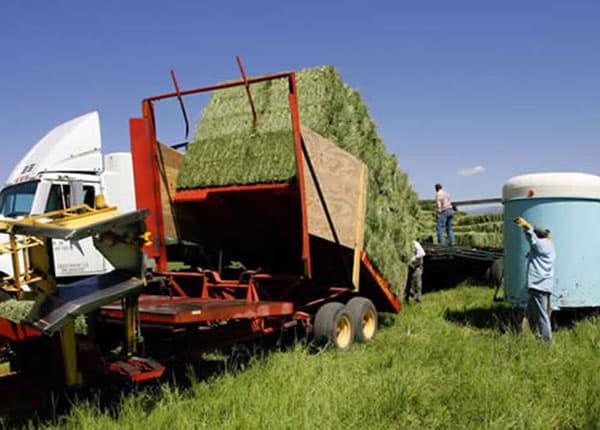
This 70-bale stackwagon was made in the 1970’s and is still in good condition. It runs off the tractor PTO and stands up a stack of 70 bales in a nice tight stack.
Smaller stackwagons are run off the tractor’s PTO, while others have their own cabs and engines. Early pull-behind versions from the 1960’s and 1970’s can be found for as little as $2,000, with good machines in good working condition running around $5,000-$10,000, depending on condition. Self-propelled stackwagons are much more expensive, usually running at least $12,000 for a good used machine and usually much more.
Another small bale stacking option is a bale accumulator. This is kind of cool—it’s a metal frame with a series of baffles that stacks small bales together in piles of six or eight bales. You can pull it with an ATV, Kawasaki Mule, John Deere Gator, or similar machine, and any kid can do it. You just pull the accumulator along and make sure the bales go in the intake. It drags the bunch of bales along until the accumulator is full, and then it drops them together in a collected stack. Then you come along with a tractor whose front-end loader has been modified to carry an attachment that can lift all eight bales at once and place them on a trailer. It’s easy to stack the bales in a barn once the trailer is loaded. Bale accumulator systems run $8,000-10,000 new. Your tractor should be at least 45 horsepower to run the loader attachment.
ROUND BALERS
Several years ago, farmers were surveyed nationwide to find out what was the greatest farming innovation in the 20th century. The overwhelming answer was “the round baler”. As I’ve mentioned several times already, round bales provide a great way to feed large quantities of hay to livestock with minimum handling, easy storage, and little labor involved in production. Round balers also require large expensive tractors to run them—a minimum of 55 horsepower and ideally up to 90 horsepower for the 5’x6’ round balers. As the technology has evolved, the balers have gotten more sophisticated. Now some balers come with computer monitors that will tell you how the hay is distributed across the bale, the weight of the bale, and when the chamber is full and the bale is ready to be tied and dropped. These balers are readily found new and used on the market. As with any baler, the newer the better, and the less hay that they’ve baled, the better. Used round balers in good condition can be found for as little as $6,000 and on up to $25,000 or more for nice new ones. Make sure the belts are in good condition and the bushings aren’t worn out.
The small round baler is a little-known baler that might be the ideal solution for a small farmer or rancher. It takes a tractor of only 55 horsepower to run a baler that will produce a 4’x5’, 900- to 1,000-pound bale. We bought a New Idea small round baler slightly used for $11,000 in 2007 and were pleased with it. It had only a simple mechanical monitor, so it could use an upgrade on the monitor, but all in all, we really like it, and our 57-hp tractor is more than able to run it.
Large round bales are a different story. The 5×6 round bales can weigh well over 1,500 pounds–sometimes up to 1,800 pounds–and require a stout tractor to make them and store them, at least 75 hp on the small end of things and up to 120 hp if you really want to do it right. Such tractors are EXPENSIVE, costing up to $85,000 new.
THE IDEAL HAYING SOLUTION
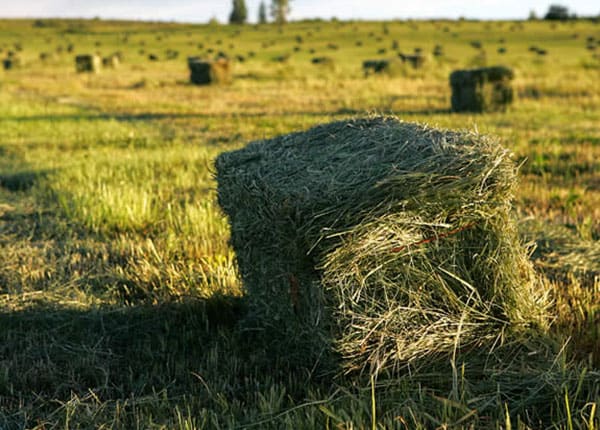
This bale of Colorado grass-alfalfa hay is ready to be picked up and stacked.
If you’re scratching your head and wondering if you can really afford all this expensive equipment, the answer might be that you can’t. You should call the custom hayer and let him cut, bale, and stack your hay to your specifications. His investment is likely several hundred thousand dollars, and his experience is vast. Haying can be a frustrating, physical, demanding job, and you probably make more money doing what you’re good at.
If you were going to be stubborn and want to put up your own hay on a 50-acre parcel, here’s what I would buy:
55-60 horsepower tractor with front-wheel assist, shuttle shift, loader, and cab. You’re going to need a tractor anyway for the wide variety of chores to do around your ranch. This tractor will spear and transport large round bales and it will easily pull a small square baler, hydroswing sickle bar swather, brush cutter, post-hole digger, and many other implements. It’s also large enough to run a small round baler. $25,000-$45,000 for a good used one or a new one.
Pull-behind or three-point hitch mounted disc mower. These pull-behind mowers can be found for $8,000-$25,000, and work well for small acreages.
Small round baler. You can find these smaller round balers new for about $18,000. They produce a nice-sized round bale, 4’ wide by 5’ tall, that weigh about 900-1,000 pounds. You get the advantages of round bale convenience and storage without having to own a very expensive large tractor. They’re hard to find used.
Small square baler. Look for a high-quality, little-used baler in good condition. You may luck into a good old baler that works well for $3,000-$5,000, but that would be great fortune. Budget up to $12,000 for a good used one.
Stack wagon or bale accumulator. If you can find a stackwagon, look it over carefully and budget up to $7,000 for a good one. Bale accumulators are a fairly new system and will cost $8,000-$10,000.
After looking at these numbers (in 2014 dollars), are you SURE you want to start cutting your own hay?
This article is copyrighted by Gary Hubbell and may not be quoted or used without his express written permission. This article is intended for informational purposes only, and no guarantees are made as to the express accuracy of the information. You are advised to consult professional advisors regarding water and property issues.
©Gary Hubbell 2007-2014, All rights reserved.
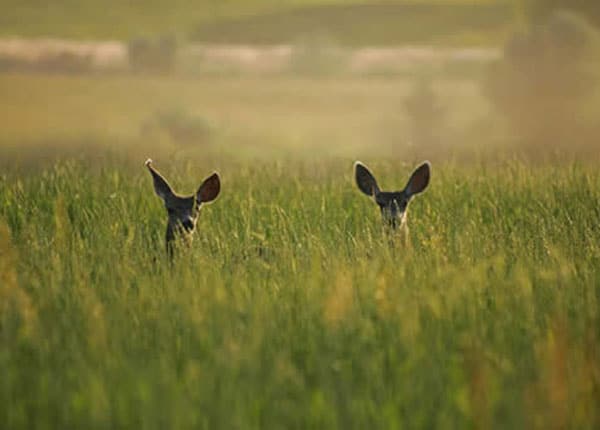
This is a good tall stand of hay! It should produce around 3 tons per acre.

